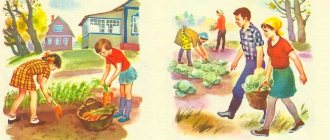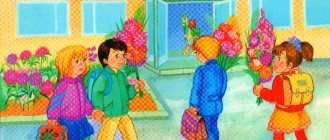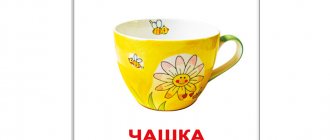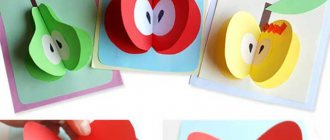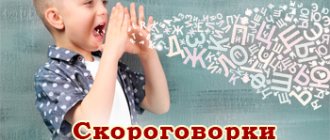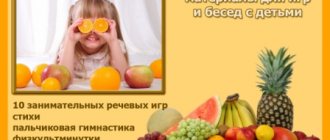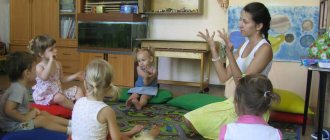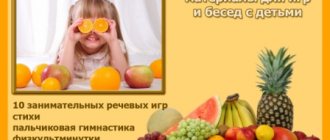How to use pictures correctly in class
If you want to fully utilize the full potential of visual material, there are several important rules to follow.
- Select only those pictures of fruits that represent the fruits as realistically as possible. Images must accurately replicate the shape, size, and external structural features of an apple or peach. This is necessary if the illustrations represent both fresh juicy fruits and dried fruits (dried apricots, apricots, etc.). It is important that children recognize not only fresh grapes, but also dried grapes, apricots, and plums.
- Children like colorful and beautiful drawings, with many details, so you should try to find these for your lessons. Attractive, bright cards hold the child’s attention for a long time and perfectly stimulate his speech activity.
- High-quality pictures of fruits for classes should be of different sizes, large and small. This allows you to use them in a wide variety of games and exercises. Subject and story illustrations with different fruits are rich material for speech development exercises.
- If you cannot find special children's pictures for speech therapy classes, then you can print suitable images from the Internet or take photographs. It is permissible, as a last resort, to draw them yourself.
- It is important that each illustration or drawing is on a separate card, the objects must be depicted against a neutral background. If you use drawn dried fruits for classes, then there should be several of them in the picture.
"Tops and Roots"
To consolidate knowledge about the way cultivated plants grow, you can play an outdoor game, for which you will need dummies or images of garden and garden fruits.
The teacher shows the picture, the children name the depicted fruit. When asked where it grows, they answer with physical actions:
- on a tree (fruit) - stretch their arms up;
- on the ground (vegetables) - stretch their arms forward;
- underground (root crops) – squat.
Tasks
Examples of tasks that can be used during lessons on the topic “Fruits”:
- Describe the appearance of several fruits using object pictures with their images.
- Compare two similar fruits (apple-peach, pear-quince, tangerine-orange), listing in detail all the common features and differences.
- Name as many characteristics of the fruit shown on the card as possible. One child, children in pairs, or the whole group can list adjectives in a circle.
- Make up a story based on the plot picture, and also come up with several questions for each picture. You can use the following options: “Fruit basket”, “How dried fruits are made”, “From seed to apple”.
- Choose an image of one fruit and come up with as many dishes from it as possible, using the correct name for each (plum marmalade - plum caramel - plum jam).
- Write riddles or short funny poems about fruits on cards.
- Carefully examine one of the pictures, and then, from memory, describe in great detail the fruit that is depicted in it.
- Make up stories in pictures based on several drawings on a topic that are related to each other.
- Using various dried and fresh fruits drawn, come up with a fairy tale about them, compose a short dialogue, and act out (using cards) a short scene.
Fruit basket
Peach
Mandarin
Lemon
Kiwi
Pear
Pomegranate
Banana
Quince
Plum
Cherry
Persimmon
Didactic game “Vegetables and fruits”
The purpose of the didactic game “Vegetables, Fruits” is to form an idea about garden and vegetable plants, the place and method of their growth, to consolidate in memory the correct names of fruits, to develop the ability to distinguish vegetables from fruits by external signs.
The middle group of kindergarteners plays an educational game.
For the lesson, you need to prepare models of trees and garden beds from dense material, and cut out recognizable images of fruits and vegetables.
The teacher lays out pictures of fruits in front of the children, asks them to name them, tell where they grow - on trees or garden beds. The students’ task is to correctly determine the place where the crop grows, attach it to a fake tree or place it on a garden bed.
Another version of the game is possible: the teacher places all the pictures on the tree, asks the children whether all the fruits are hanging correctly and which ones need to be moved to the garden.
For the older group of kindergarteners, you can complicate the task by offering:
- separate fruits and root vegetables by color;
- name the geometric shape of vegetables and fruits;
- ask what can be put in a dessert vase and what can be used to make a salad.
Games
It is useful to organize various educational games for children with images of fruits. Here are some examples:
- Guess what?
Identify the hidden fruit from the description by selecting its image from several laid out on the table.
- Let's fill the basket
Find among the drawn fruits one about which you can say:
– round, rosy, sweet; – bright, aromatic, sour; – leathery, heavy, smooth, etc.
The card with the guessed fruit is put into a box on which a basket of fruit is drawn among the trees.
- Fourth wheel
Select four pictures so that three have something in common, and the fourth is superfluous.
For example: dried apricots, apple, prunes, raisins (three are dried fruits, but the apple is not).
For this game you can use additional cards: berries and fruits, for example.
- Ripe alphabet
Choose any letter, and then, as quickly as possible, remember a fruit or several whose names begin with it. It’s good if the complete “fruit alphabet” in pictures is used for other games and the child is already familiar with it.
- Whose piece?
Based on the image of the cut, you need to guess the whole fruit as quickly as possible.
- Harvesting
Using fruits on a transparent background, create a beautiful still life on a special screen. The full fruit basket is then closed and the child is asked to name everything that is inside it.
Goal: expand children's knowledge about fruits.
Tasks:
Teach children to form nouns using diminutive suffixes. Strengthen the ability to correctly form the Rod form. noun case. Learn to form adjectives from nouns correctly. To develop the ability to identify a vowel sound in a word based on visual symbols. Develop auditory attention. Develop fine motor skills of the fingers. Develop proper speech breathing. Improve articulatory motor skills. Develop attention, memory, logical thinking, visual perception. Equipment: pictures of fruits, natural fruits, teaching aid “What kind of juice?” ("jars" with juice), handout symbols of the vowel sound "a", cut-out pictures, a package from Grandma Riddle.
Progress of the lesson.
1. Organizational moment.
Download abstract
Speech therapist. Let's get ready for the lesson and do self-massage.
Autumn has come to visit and invited us to the garden. Don't be lazy - keep up, Harvest the harvest.
(Stroking movements. From the middle of the forehead to the top of the ears, from the nose to the middle of the ears, from the middle of the chin to the bottom of the ears).
Now let’s sit down and affectionately name the fruit that is shown in your picture.
D/i “Call me affectionately”: I have an apple, I have a lemon, I have a pomegranate, etc.
2. Report the topic of the lesson.
Speech therapist. Guys, you just sat down and named different... (fruits). Today in class we will remember what you already know about fruits and learn a lot of new and interesting things about fruits.
Let's draw fruit using our lips and cheeks (in front of the mirror).
Articulation exercises: “Apple cheeks”, “Hide the plum behind the cheek”, “Round grape”, “Banana”.
3. Didactic game “Who is the most attentive?”
Speech therapist. Now let’s play the game “Who is the most attentive?” I will name different fruits. If you hear an “a” sound in the name of a fruit, raise the “a” sound symbol.
Pears, oranges, plums, bananas, pineapple, figs, grapes, dates, persimmons, lemons, quince.
4. Guessing riddles about fruits.
Speech therapist. Guys, let's remember what you already learn about fruits.
-Where do fruits grow? - Fruits grow in the garden.
-What do fruits grow on? – Fruits grow on trees.
-What can be prepared from fruits? – You can make juice, compote, jam, jam, etc.
(Knock on the door).
Speech therapist. Guys, someone is knocking. Look, they gave us a parcel, and there is a letter in it. This is a letter from Grandma Riddle. She sent you riddles. If you guess them, you will find out what is in the package. (The speech therapist asks riddles and takes out fruits that provide clues. Places them on a tray).
Juicy, crispy, Sweet, shiny, Red, green, Yellow, soaked.
Important, thick-skinned, like the sun. A slice of juice will splash, acid - and that’s all.
This sissy is from the south, round and fresh. There is fluff on his cheeks, just touch him and juice will splash.
The orange balls are finger-licking delicious, but I don’t play with them, I eat them with pleasure.
I won’t tear the rosy doll away from my friends. I'll wait until the nesting doll falls into the grass on its own.
5. Didactic game “Remember and put down”
Speech therapist. Now let’s play the game “Remember and Put” with Grandma Riddle’s fruits. (The speech therapist names 4 fruits, the child comes to the table and lays out the fruits in the given sequence).
6. Didactic game “What’s missing?”
(5-6 fruits are laid out in a row. The speech therapist gives the command “night” and the children close their eyes; then the speech therapist hides one fruit and gives the command “day”, the children open their eyes. The speech therapist asks the question: “What is missing?”)
7. Dynamic pause.
Speech therapist. Guys, Grandma Riddle invites you to visit her. She has a wonderful orchard. (They go out onto the carpet). So we found ourselves in an orchard. There were a lot of apples ripe in it. Let's collect them. We pick apples from a high branch. We raise our hands up - inhale. We put apples in the basket - exhale (we lower our hands).
A fragrant pear grows on a nearby tree. Let's inhale its aroma: inhale through the nose, exhale: “Ah!”
Now let's pick a quince and try its fruit. It is not yet ripe, sour. Inhale through the nose, as you exhale: “Fa-fo, fu-fu.”
-Who takes care of the garden? - Gardener.
-Let's show what we do, gardener.
Plastic studies.
The gardener digs holes, plants fruit trees, whitewashes tree trunks, prunes, and sprays trees. (Children imitate the actions of the gardener.)
8. Finger gymnastics.
Now let's show the gardener how to cook compote.
We will cook compote. We need a lot of fruit. Here: We will chop apples, We will chop pears,
Squeeze out the lemon juice, add the drain and sand. We cook, we cook compote, Let's treat the honest people.
9. Formation of relative adjectives.
Speech therapist. While we were walking in Grandma Zagadushka’s garden, jars of juice appeared on your tables. Tell me what kind of juice you have.
Children: I have apple juice - apple juice
I have banana juice - banana juice, etc.
10. Working with cut-out pictures depicting fruits.
Speech therapist.
On the count of “one” - take the envelope, “two” - open and look, “three” - collect the picture.
(Children have individual envelopes on their tables with cut-out pictures of varying levels of complexity)
11. Summary of the lesson, assessment of children’s activities.
What fruits to give to children
First of all, let us remind you that it is better to give children fruits in season. There will be no benefit from imported strawberries in winter, but there is a risk of poisoning from any chemicals. Also, do not choose fruits that look like they came off the covers of glossy magazines. Waxed ones are also not useful. Choose ordinary, but cute ones, preferably ours, not imported ones, preferably from your own plot.
- Alternate fruits, try to diversify your baby's diet. Give preference to fresh, and not in the form of compote, jam, etc.
- Remember that the peel is a place where all sorts of useful things accumulate, so do not cut off the peel of a fresh fruit, but simply wash it well. Only for a very young child who cannot chew, cut off the peel.
- If the child does not want to eat fruit separately, make a fruit salad in a beautiful bowl. Top with sour cream or natural yoghurt. Let the baby eat to his health.
Should I give my child exotic fruits?
Scientists and doctors have long proven that a child’s body responds better to the products of the area and region in which he grew up. That is, it is better to start complementary feeding with domestic apples and pears. Even bananas and oranges are best not given until 2 years of age.
You should not give exotic fruits - mango, papaya or lychee - from an early age. It’s better to let your baby’s body get stronger, let his digestive system work fully and correctly. There is no need to give her surprises in the form of unusual fruits, at least until she is 4-5 years old.
Fruits contribute to the harmonious and healthy development of the child’s body because they contain a large amount of vitamins and minerals. But do not forget that excessive consumption of any fruit can cause allergies and other unpleasant consequences. In everything you need to observe moderation.
TOP 15 best fruits for baby food
Fruits can be used as a snack or replaced with candies and sweets. They are rich in vitamins of various groups: A, B, C. They contain iodine, zinc, iron, selenium, as well as macroelements such as phosphorus, sodium, calcium, magnesium.
It is better to choose fruits according to the season, since the quality of imported products can be doubtful. Give your child a variety of fruits; don’t just focus on apples or bananas.
Hard fruits are useful and pleasant to chew on; it develops teeth and gums. It is advisable to eat fruits fresh, but for variety you can bake them.
Grapefruit
Grapefruit is considered very useful due to its high dose of vitamin C, minerals, essential oils, fiber and phytoncides. Phytoncides help suppress the growth and development of bacteria in the child’s body, and fiber contributes to the normal functioning of the gastrointestinal system.
Thanks to a large amount of vitamin C, grapefruit fights diseases and infections, helps with colds and viral diseases. Its regular use will support the child’s body during the period of spring and autumn vitamin deficiency.
Grapefruit is recommended to be included in the diet of children with diseases of the cardiovascular system. Vitamin B helps regulate the functioning of the child’s nervous system. This fruit increases stamina and helps fight drowsiness and lethargy.
The only drawback of grapefruit for children is its bitter taste. But it is not contained in the whole fruit, but only in the partitions and films. The pulp itself is sweet and juicy, pleasant to the taste.
It is better to eat grapefruit fresh; you can add it to fruit salads or make juice. But be careful with the juice - a high concentration of vitamin C can cause allergic rashes and irritation of the gastric mucosa. Mix concentrated juice with water.
Apples
Only the lazy have not heard about the benefits of apples: “Whoever eats an apple a day never sees a doctor,” says the famous saying. Apples are rich in vitamins C and B, iron, potassium, antioxidants, pectin and fiber.
Pectin helps remove toxic substances from the child’s body and cleanse it. It also helps normalize the functioning of the gastrointestinal tract and improves appetite.
Thanks to iron, apples improve the composition of a child’s blood and are prescribed for childhood anemia. Apples contain a lot of vitamin C, so they help fight viral and colds. Thanks to the content of vitamin B6, they promote sound sleep for the child.
Most of the nutrients are found in the peel and seeds of the apple. It is better to give it to the child whole, or cut into slices.
Lemon
Lemons have a sharp, sour taste, so including them in children's diets is not easy. But it’s worth it: lemon ranks first among fruits in terms of vitamin C content. It will kill any cold at the initial stage, and you will be able to avoid the use of antibiotics and other medications.
Lemon has antibacterial and antiviral effects thanks to vitamin C and phytoncides, which remove toxic substances from the body and fight infections. Due to the high concentration of vitamins in lemon, it supports the child’s immunity and helps avoid illnesses during vitamin deficiency.
Doctors recommend including lemon in a child’s diet no earlier than 1 year. You can sprinkle sugar on lemon and add it to tea or drink it as juice diluted with water. But be careful: when including lemon in the diet, monitor all changes in the child’s body. Like any citrus fruit, it is a strong allergen and can cause stomach irritation.
Banana
Bananas have become a part of our daily diet. This fruit is rich in fiber, vitamins C and B, the amino acid tryptophan, as well as calcium, iron, and potassium.
Due to the content of B vitamins, bananas are beneficial for the nervous system. They promote the production of the happiness hormone endorphin - due to the amino acid tryptophan. Bananas help improve the functioning of the gastrointestinal tract and help with diseases of the cardiovascular system.
Banana is a high-calorie fruit; you should limit its consumption to 1 piece per day if your child is overweight. You will have to exclude it from the diet if you are allergic to it.
Orange
Orange is a fruit rich in vitamins, minerals, and antioxidants. 100 g of orange contains the daily requirement of vitamin C for an adult.
Orange is considered the leader in effectiveness in the fight against colds and flu. It will become a reliable helper for a child during epidemics and vitamin deficiency. Salicylic acid will help relieve fever if you do get sick, and improves immunity.
It is better to eat oranges fresh; you can drink freshly squeezed juice if you are not allergic. But the juice contains less fiber than the whole fruit and only retains its beneficial effects for 30 minutes.
Pear
Pear is a tasty and healthy fruit with a high content of B vitamins. It contains ascorbic acid, calcium, sodium, iron, phosphorus and magnesium. It is a source of fiber, which helps the functioning of the gastrointestinal tract.
Ascorbic acid in pears will help cope with various colds: reduce fever, relieve symptoms. The body will be able to fight the virus on its own.
Pears can be consumed whole, cut into slices, or added to compote.
A pineapple
Pineapple is not the most familiar fruit for Russian residents; we often see foreign products in stores. It is rich in vitamins B and C, special alkaloid substances, beneficial acids and minerals.
Thanks to its mineral and vitamin complex, as well as ascorbic acid in its composition, pineapples help fight viral and colds. Pineapple contains the substance bromelain - it helps fight excess weight by improving metabolism and accelerating the process of fat breakdown.
If your child is overweight, pineapple will help get rid of it.
The fruit stimulates digestion and helps remove harmful substances from the body. It is better to buy fresh, juicy fruits rather than canned ones - they contain too much sugar.
Mandarin
It is simply a storehouse of nutrients, minerals and amino acids. It is rich in vitamins A, B, C and D, magnesium, iron, calcium and sodium.
Tangerines improve the functioning of the cardiovascular, nervous and digestive systems, promote concentration and energize. The fruit helps get rid of insomnia, diarrhea, and depression.
Tangerines are excellent at fighting colds and infections, easing the course of the disease, and increasing immunity. They strengthen the child’s teeth and bones, improve mood, quench thirst, and reduce temperature.
When including tangerines in a child’s diet, you need to carefully monitor his body’s reaction; tangerines are a strong allergen. It is better not to give your child fruit before 1 year of age.
Apricot
Apricot is a source of vitamins A, B and C, minerals, phosphorus and pectin. This fruit helps cope with infectious and viral diseases, normalizes intestinal function, helps the pancreas and kidneys, and improves immunity.
Apricots accelerate metabolism and cell regeneration, and help heal wounds on the body. They are rich in iron, so they are included in the diet of children with anemia or to prevent it.
You can eat apricots fresh, dried, cook compote from it and make jam or jam.
Persimmon
Persimmon is a generous source of vitamins and minerals for children's bodies. Has an astringent effect. Rich in vitamins A, C and P, carotene, iodine, iron.
Persimmon helps improve vision, is a natural energy booster, and charges your child with vigor and energy for the whole day. Helps fight viral infections, strengthens the cardiovascular system, improves the functioning of the nervous system. Due to its high iodine content, persimmon is also beneficial for the child’s endocrine system.
Persimmon should not be given to a child under 3 years of age; its astringent properties can cause intestinal obstruction. After introducing persimmons into the diet, carefully monitor the child’s condition and note any changes in his body.
Plum
Plums are rich in vitamins B, E and P, iron, phosphorus, calcium, pectin and iodine. Their composition helps the functioning of your child's gastrointestinal, endocrine and nervous systems. It also strengthens bones and teeth.
The fruit improves digestion and appetite, promotes the formation of red blood cells in the blood, strengthens the liver and kidneys, and the walls of blood vessels. Plums can be used to lower body temperature during colds or flu.
In large quantities, plums can cause diarrhea. Make sure your child doesn't eat too much.
The optimal age for a child to introduce plums into his diet is 8-9 months, not earlier. You can make puree, juice from them, and also add them to desserts.
Cherry
Cherry is considered the queen of fruits and is rich in vitamins A, C and E, iron, phosphorus, magnesium, calcium, pectin, and ascorbic acid.
Cherries contain coumarin, which helps improve blood quality. It reduces its viscosity and is used to prevent the formation of blood clots. Pectins improve the functioning of the gastrointestinal tract, vitamins C fight colds and viral diseases.
Ascorbic acid boosts immunity and relieves cold and flu symptoms. Cherries may improve the effectiveness of medications in the treatment of epilepsy in children.
Children may find cherries too sour; you can make jam and jam with added sugar, compotes and fruit drinks from them.
Cherries
Cherries contain vitamins E, C, H, P and group B, micro and macroelements - potassium, calcium, phosphorus, copper, iodine, zinc and others. Cherries boost immunity and give your children a boost of vigor and energy.
It helps the heart function, maintains proper heart rhythm, and strengthens the walls of blood vessels. Being a natural antioxidant, cherries remove harmful and toxic substances from the body. The high content of vitamin C and ascorbic acid speeds up the recovery process from a cold or flu.
Cherries are a strong allergen, so after introducing them into your child’s diet, carefully monitor his reaction. You can start trying to give cherries to your child from 8-9 months in the form of juice, compotes or fruit drinks.
Grape
Scientists still cannot decide: are grapes a berry or a fruit? It is called a wineberry, but we are accustomed to perceive it as a fruit. Grapes are rich in vitamins A, B, C and D, calcium, phosphorus, ascorbic acid, potassium and magnesium.
Grapes have a general healing effect, keep the immune system in good shape, and are useful for the respiratory system of the body. The berry (or fruit) has a beneficial effect on the digestion process, however, it is important not to overuse it - in large quantities, grapes can cause intestinal upset and diarrhea.
Strengthens the nervous system, helps to overcome stressful situations more easily. It has a positive effect on mental activity; its effect can be compared to chocolate.
Grapes are a high-calorie product; you should not abuse them, especially for overweight children.
It is recommended to introduce it into the baby’s diet no earlier than 2 years. This is mainly due to the load on the organs of the digestive tract. Give the grapes a little at a time, carefully monitoring the body's reaction.
Peach
Rich in malic and citric acids, vitamins C, B and E, carotene, pectin and other beneficial substances. Promotes good functioning of the digestive tract, cardiovascular system, as well as the nervous and protective systems.
The substances contained in peach help strengthen the child’s muscle corset and his skeleton. Thanks to zinc and phosphorus, internal organs will develop correctly. Peach is great for fighting colds and viral infections.
Guess by description
A didactic game about fruits and vegetables is built in the form of questions and answers. The teacher names the signs, asks what vegetable he described, and the children must guess and answer. For example:
- red, round, juicy, fleshy (tomato);
- sharp, hot, white inside, with a yellow husk, with thin leaves (onions);
- green, oval, crispy, covered with pimples (cucumber);
- large, round, orange, with a thick crust, with healthy seeds (pumpkin);
- long, triangular, orange, grows in the ground, with curly greenery (carrot).
